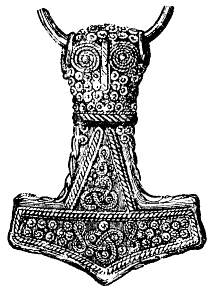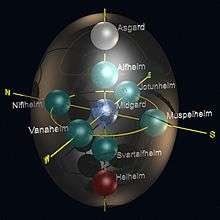Norse cosmology
| Norse Anthropology |
|---|
 |
|
Categories
|
The cosmology of Norse mythology has "nine homeworlds" or "nine realms", unified by the world tree Yggdrasil. Mapping the nine worlds escapes precision because the Poetic Edda often alludes vaguely. The Norse creation myth tells how everything came into existence in the gap between fire and ice, and how the gods shaped the homeworld of humans.
Yggdrasil
A cosmic ash tree, Yggdrasil, lies at the center of the Norse cosmos. Three roots drink the waters of the homeworlds, one in the homeworld of the gods, the Æsir, Asgard, one in the homeworld of the humans, Midgard, and one in the homeworld of the dead, Helheim. Beneath the root in the world of the frost giants is the spring of Mímir, whose waters contain wisdom and understanding.
The root in the Æsir homeworld taps the sacred wellspring of fate, the Well of Urðr. The tree is tended by the Norns, who live near it. Each day, they water it with pure water and whiten it with clay from the spring to preserve it. The water falls down to the earth as dew.
Animals continually feed on the tree, threatening it, but its vitality persists evergreen as it heals and nourishes the vibrant aggression of life.[1] On the topmost branch of the tree sits an eagle. The beating of its wings cause the winds in the world of men. At the root of the tree lies a great dragon, Niðhǫggr, gnawing at it continuously, together with other unnamed serpents.[2] The squirrel Ratatoskr carries insults from one to the other. Harts and goats devour the branches and tender shoots.
Creation
In the beginning, there were two regions: Muspelheim in the south, full of fire, light and heat; and Niflheim in the north, full of arctic waters, mists, and cold.[3] Between them stretched the yawning emptiness of Ginnungagap, and into it poured sparks and smoke from the south and layers of rime and glacial rivers from the north. As heat and cold met in Ginnungagap, a living jǫtunn, Ymir, appeared in the melting ice. From his left armpit, the first man and woman were born. From his legs, the frost jötnar were born, making Ymir the progenitor of the jǫtnar. Most sources identify Ymir's oldest son as Þrúðgelmir, who bore Ymir's grandson, Bergelmir. The other jǫtnar are usually unnamed. Ymir fed on the milk of the cow Auðumbla. She licked the blocks of salty ice, releasing Búri.
Búri's son Borr had three sons, the gods Odin, Vili and Vé. The three slew Ymir, and all of the jötnar (giants) except for Bergelmir and his wife, who were drowned in the blood of the others. From Ymir's body, they made the world of humans: his blood the seas and lakes, his flesh the earth, his bones the mountains and his teeth the rocks. From his skull they made the dome of the sky, setting a dwarf at each of the four corners to hold it high above the earth. They protected it from the jötnar with a wall made from Ymir's eyebrows. Next they caused time to exist, and placed the orbs of the sun and moon in chariots which were to circle around the sky.
Odin, passing through the world of the jötnar, found two beautiful young giants named Sól and Máni, sun and moon. They were brother and sister, and their father had named them after the beautiful lights in the sky. Odin decreed that Sól and Mani should drive the chariots of the sun and the moon across the sky, and to ensure that their journey was always constant and never slowed, he created two great wolves. These wolves were called Hati and Sköll, and they were placed in the sky to pursue the chariots and devour them if they caught them.
Norse gods
The realm of the Norse gods, the Æsir, is called Asgard or the "Court of the Ás". The Æsir built it after the homeworld of humans, and it contains many halls.[4] Odin's hall, Válaskjálf, is roofed in silver. He can sit within it and view all the worlds at once. Gimli, a hall roofed in gold, to which righteous men are said to go after death, also lies somewhere in Asgard. Valhalla, the hall of the slain, is the feast hall of Odin. Those who died in battle are then raised in the evening to feast in Valhalla. Two important gods, the brother and sister, Freyr and Freyja, are citizens of Asgard but actually exchange-hostages from Vanaheimr. Heimdallr, the gods' warden, dwells beside Bifröst, the rainbow bridge. Each day, the gods ride over Bifröst to their meeting place at the Urðarbrunnr.
Nine homeworlds
The phrase "nine homeworlds" is Níu Heimar in Old Norse. Relating to another term heima meaning "home" or "homestead", the term heimr means a "place of abode" in the sense of a homeland or region, or in a larger sense a world.[5]
The nine homeworlds are not listed in surviving texts, though based on places mentioned in the myths, the most common listing in modern recreations are:
- Asgard, the home of the Æsir ruled by the god Odin
- Álfheimr/Ljósálfheimr, the home of the Ljósálfar
- Niðavellir/Svartálfaheimr, the home of the Dwarves who are also synonymous with the Dökkálfar and Svartálfar
- Midgard (Earth), the home of humans
- Jötunheimr/Útgarðr, the home of the Jötnar (Giants)
- Vanaheimr, the home of the Vanir
- Niflheim, a world of ice and snow
- Muspelheim, a world of fire and lava and home of the Jötunn Surtr
- Hel(heimr), the home of the dishonorable dead sometimes synonymous with Niflheim and ruled by the goddess Hel
Poetic Edda
In the Poetic Edda, the phrase Níu Heimar occurs in the following Old Norse texts.
- Völuspá 2
- I remember the nine worlds, nine giantesses [who personify each land], the glorious [world tree], Mjötviðr [that unites them], before the ground below [existed].
- Níu man ek heima, níu íviðjur, mjötvið mæran, fyr mold neðan.
- Vafþrúðnismál 43
- I can say truly [about] the secrets from the Jötnar and all the gods, because I have come [traveling] over each world. I came [traveling over each of] the nine worlds, [even to the remotest places in each one], [even] before Niflhel below [where people] from Hel die.
- Frá jötna rúnum ok allra goða ek kann segja satt, þvíat hvern hefi ek heim of komit. Níu kom ek heima, fyr Níflhel neðan; hinig deyja ór helju halir.
Prose Edda
In the Prose Edda, the phrase occurs here.
- Gylfaginning 34
- [Óðinn] threw Hel [the deity of death] into Niflheimr and gave her authority over the nine worlds.
- Hel kastaði hann í Niflheim ok gaf henni vald yfir níu heimum.
Counting the worlds
_The_Cosmos_in_the_Norse_mythology.jpg)

In the Poetic Edda, the poem Alvíssmál has a stanza that lists six worlds, clarifying each "homeworld" (heimr) is the realm of a different family of beings. Þórr asks: What is the wind named "in every world" (heimi hverjum í)? Álvíss answers:
- Alvíssmál 20
- It is named "wind" with the Humans.
- But "waverer" with [the Æsir] the gods.
- [The Vanir] the enchanting-rulers call it "neigher" [making sounds like a horse].
- The Jötnar "shrieker" [during deadly arctic storms].
- The Álfar "whistler".
- In Hel, [the dead] call it "squall" [a sharp increase in wind speed before a rain].
- Vindr heitir með mönnum.
- en váfuðr með goðum.
- kalla gneggjuð ginnregin.
- æpi jötnar.
- alfar dynfara.
- kalla í helju hviðuð.
Thus there are at least six worlds, each being the homeworld of a particular family of beings. They can be inferred to correspond to the following place names mentioned elsewhere in the Poetic Edda and Prose Edda.
- 1. Menn (humans): Miðgarðr.
- 2. Aesir (gods): Ásgarðr.
- 3. Vanir (gods): Vanaheimr.
- 4. Jötnar (giants): Jötunheimr/Útgarðr.
- 5. Álfar (elves): Álfheimr/Ljósálfheimr.
- 6. Náir (corpses, the dishonorable dead): Helheimr.
The homeworld of the Dvergar is missing from the above list. Elsewhere, the poem mentions the Dvergar separately from the other families of beings. For example, Alvíssmál 14 lists the Dvergar as distinct from the Álfar. Moreover the two place names, Álfheimr and Svartálfaheimr, confirm there are two separate heimar or "homeworlds", one for each family. The byname Svartálfar or "Black Elves" refers to the Dvergar.[6] and likewise Svartálfaheimr or the "Homeworld of the Black Elves" is the home of the dwarf Brokkr (Skáldskaparmál 46). Alternatively, the home of the Dvergar is called Niðavellir or the "Downward Fields" (Völuspá 37). Thus, these families of beings mentioned in the poem Alvíssmál are identified with seven of the nine homeworlds.[7]
- 7. Dvergar (dwarves): Niðavellir/Svartálfaheimr.
Seven homeworlds for seven families of beings. The last two of the homeworlds are less certain. Usually, the list adds the primordial realms of the elements of ice and fire, counting them as "homeworlds".[8][9] The place name of the element of ice, Niflheimr, means the arctic "Mist Homeworld", suggesting it is one of the "Nine Homeworlds".
- 8. Primordial element of Ice: Niflheimr.
- 9. Primordial element of Fire: Múspellsheimr.
Uncertainty
The above identities for the Nine Homeworlds are common. However the relationships between these and other significant realms have resulted in confusion. Precise mapping remains uncertain. For example, Hel is said to be located in Niflheim:[10]
- As for Hel, ... Odin sent her down into the realm of mist and darkness, Niflheim. There she rules a kingdom encircled by a high wall and secured by strong gates.
Later scribes may have believed Hel, or at least Niflhel, was identical with Niflheimr. Properly, Niflhel is the lowest level of Hel where the evil dead suffer torment, whereas Niflheimr is the primordial realm of icy mist, yet some early manuscripts consistently confuse these two names.[11]
- "The confusion between Niflheim and Nifhel is summed up by variation in the manuscript of Snorri's [Prose] Edda. In describing the fate of the giant master builder of the wall around Asgard, two of the four main sources say Thor bashed the giant's head and sent him to Niflheim, and the other two say Thor sent him to Niflhel."[12]
The primordial Niflheimr and the punishing Niflhel are "equally dreadful" places;[11] it is not clear whether they are identical or distinct.
See also
Notes
- ↑ Davidson (1988), p. 171.
- ↑ Crossley-Holland (1980), pp. xxii-xxiii.
- ↑ Davidson (1964), p. 27.
- ↑ Davidson (1964), p. 28.
- ↑ Zoega (1910), "heimr", "heima".
- ↑ Orchard (1997), "Black Elves".
- ↑ Davidson (1988), p. 172.
- ↑ Enoksen, Lars Magnar (2008). Norrøne guder og myter
- ↑ Simek, Rudolf (1993). Dictionary of Northern Mythology.
- ↑ Davidson (1964), p. 32.
- 1 2 Orchard (1997), "Niflheim".
- ↑ Lindow (2001), p. 241.
References
- Crossley-Holland, Kevin (1980). Norse Myths: Gods of the Vikings. Penguin Books.
- Davidson, H. R. Ellis (1964). Gods and Myths of Northern Europe. Penguin Books.
- Davidson, H. R. Ellis (1988). Myths and Symbols in Pagan Europe: Early Scandinavian and Celtic Religions.
- Lindow, John (2001). Handbook of Norse Mythology. ABC-CLIO. ISBN 1-57607-217-7.
- Orchard, Andy (1997). Dictionary of Norse Myth and Legend. Cassell. ISBN 0-304-34520-2.
- Zoega, Geir T. (1910). A Concise Dictionary of Old Icelandic.
